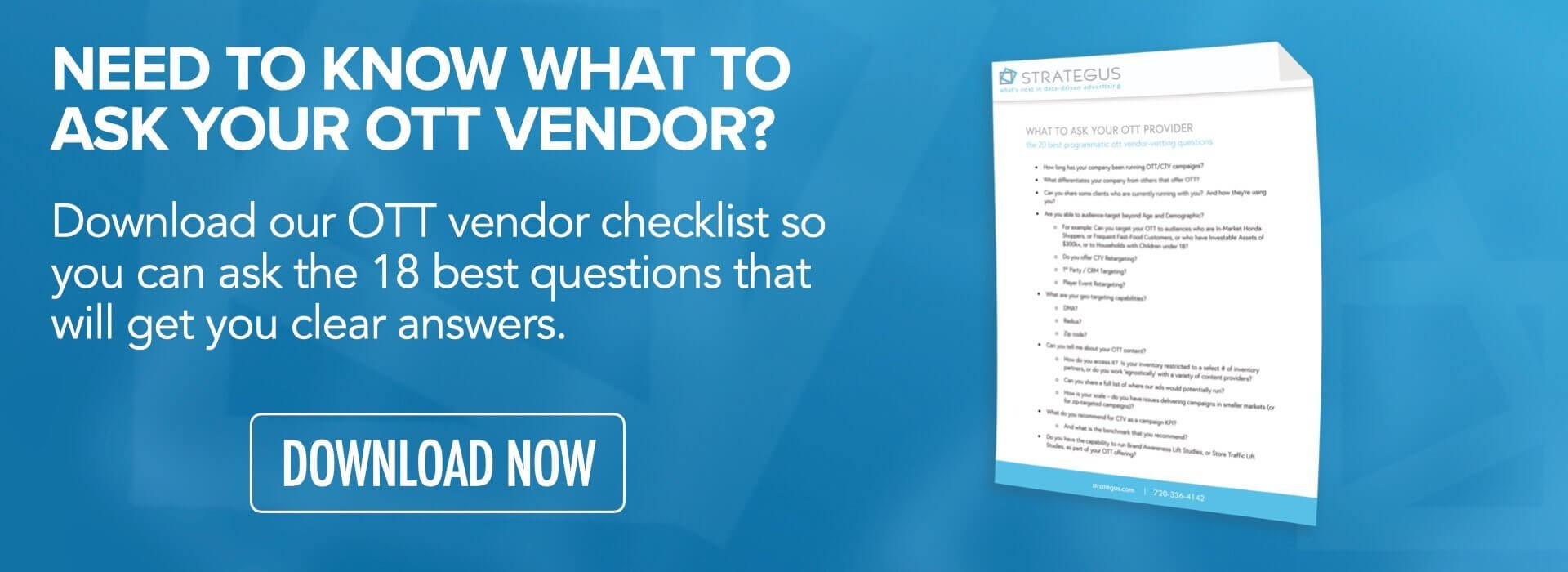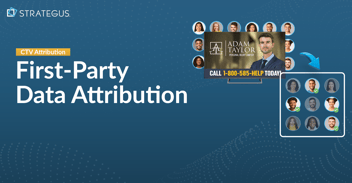- Home
- Strategus Blog
- Post Pandemic Advertising: How Covid Changes Streaming Ads
Post Pandemic Advertising: How Covid Changes Streaming Ads
 Andy Dixon
Andy Dixon
8 minutes read

The arrival of the coronavirus pandemic caught everyone by surprise, dramatically changing the day-to-day routines that we were accustomed to, including media consumption. The introduction of social distancing orders and stay-at-home policies pushed consumers into their homes, where marketers observed a dramatic increase in the amount of video streaming, particularly on internet-connected TVs and other streaming devices.
Even prior to COVID-19, there was already data that showed digital streaming viewership had begun to resemble linear/traditional TV. In fact, digital video is one area that continues to remain stable despite the countless number of paused or canceled campaigns. Rather than slowing down in terms of growth, it appears that the pandemic has only accelerated the growth streaming TV and ad spend.
In fact, IAB projected that CTV spend would hit $16MM per advertiser for 2020–a prediction that looks to be coming to fruition as a surge of buyers move dollars away from conventional broadcast and cable over in favor of streaming advertising.

What are the best ways to optimize the effectiveness of your streaming advertising campaigns?
With a greater emphasis being placed in the streaming sector of the advertising world, we can anticipate that it won’t be long before the space becomes more saturated with more advertisers competing for similar audiences. As with any evolving technology, it is crucial to know what best practices to follow as well as what to avoid. As marketers, there are already a lot of moving pieces at play with any campaign, from brand image and brand safety to performance metrics and attributions. Factor in specific logistics that have to do with streaming advertising, and it can seem a bit overwhelming to stay up-to-date.
Strategus has analyzed all of our best campaigns to put together a contemporary guide of best practices to help maximize the effectiveness of your streaming advertising campaigns
1. Use GPS location data-based audience targeting to drive traffic to physical locations and/or base targeting on locations where people have been
Beyond media consumption, brick-and-mortar businesses have been dramatically affected by the new social restrictions put in place due to COVID-19. With the current level of unrest and uncertainty, there needs to be an extra level of empathy in the campaign messaging first and foremost, but it’s also time to be smarter about streaming ad spend with a pre-qualification of that audience based on their movements in the physical realm. What do we mean? By leveraging audience targeting that uses (phone) GPS location data there are two key scenarios that will lead to a much more qualified audience from an intent perspective and subsequently a more effective ad spend:
- Supporting brick and mortar businesses with an audience qualification layer that only advertises to people who are willing to leave their homes during this time.
- Many locations have taken extra precautions to reopen during the pandemic, but are still seeing a decline in foot traffic. By leveraging real-time location data based on the GPS within a user’s mobile device, campaigns can target individuals within a certain radius or polygon of a business storefront and help push that consumer towards the location. Learn more in this article.
- Using the GPS data as a meter for “real-world intent”
- Here at Strategus, we feel that in some scenarios the frequency and category of locations people visit physically may glean a greater metric of purchase intent than what they look at in their web browser. The sky’s the limit on how specific you want to get in this realm and it can be blended with other forms of targeting including online behavior, demographics, purchasing behavior, etc. to really help whittle your audience down to only the high-volume “super-users” of whatever product or service you have to offer.
Although this targeting practice leveraging real-time GPS data is highly relevant during COVID times, it will also be just as relevant 2021 and beyond.
2. Optimize streaming ad spend by giving extra attention to pacing and timing
This is one of the most critical factors for any campaign, that is more relevant now than ever before. Managing the ad budget is one of the background tasks that doesn’t take a lot of time, but can be the major difference between a campaign succeeding or flopping. There are two major parts to optimizing ad spend:
- Pacing – The pacing should be smooth and flow for the duration of the campaign.
A rookie mistake would be utilizing an entire month’s budget within the first few days. Not only is this poor budgeting, but it also takes away the opportunity to adjust and tweak the ad if it does not generate results. The concentrated window of time would also make it difficult to determine the success or failure of a result. Make sure that you begin conservatively and allocate your budget as you gather data from the initial results.
- Timing – Ensure that the ad is being served when it is most relevant to the consumer.
With streaming advertising, we have the capability to target individuals based on their respective behaviors and habits. This means we can serve ads when it is most likely actionable to the consumer. For example, you can serve the same exact ad for a food delivery service to the midnight snacker and the early dinner individual at different times in order to optimize the ROI. During COVID times, this can also be used to target the parents later in the evenings when they are home from work and the younger house members before dinner.
3. Take a blended approach and use a combination of streaming ads with other channels
With advertising, there is a delicate balancing act between making sure that the message is received and making sure that the consumer is not feeling spammed by the same ad repeatedly. Being able to find this middle ground will go a long way towards how successful the campaign is. This is more difficult said than done, but we believe the best “catch-all” solution is to take a blended approach, that is adjusted per each campaign goal.
Having a blended strategy means leveraging multiple different platforms in order to subtly reinforce the brand message, without overloading an ad in one area, which can lead to faster creative fatigue.
Depending on the brand or the campaign goal, a blended approach might include one or more of the following:
- Streaming (CTV) + Retargeting Combination
- This is probably the most common method. Leveraging a blend of streaming advertising (via CTV) and post-ad completion retargeting together on their other devices (laptops, mobile devices, game consoles, etc.) is the perfect opportunity for sequential messaging and can make CTV “actionable” IE drive website conversions.
- Streaming (CTV) + Programmatic Display Combination
- When consumers observe ads from the same brand on different mediums, such as audio, browsers, and other programmatic displays, brand resonance is going to be much much higher.
- Streaming (CTV) + Paid Search Combination
- Subtly placing sponsored content from the brand prior to or following a streaming ad can help reinforce the intent to purchase within a consumer’s mind. In fact, it might be what pushes a transaction through to completion.transaction.
- Streaming (CTV) + Any / All of the Above
- In general, having a reiterative narrative arc will create a stronger impact than using one channel alone. There is a lot of room to get creative and sometimes, you may need to use multiple channels to accomplish the end goal.
4. Leveraging first-party data and lookalike audiences to expand your target pool and/or reactivate an existing pool of contacts
So you’ve successfully run a campaign that generated results beyond what you were expected and you want to repeat that success and/or you have a large pool of ideal customers in your CRM that need to be reactivated without risking them unsubscribing from a giant email blast. Or perhaps you are noticing a lot of attributions associated with a demographic that you weren’t anticipating.
This is where we recommend leveraging data to find lookalike audiences–individuals who share similar interests, hobbies, behaviors, etc. with some minor variances. This will give you sophisticated groups of people who are most like individuals that have already engaged with the brand, which will help optimize the effectiveness of the campaign as a whole as well as expanding reach in a strategic fashion
Read more on the differences between first, second, and third-party data here
The Bottom Line
The streaming advertising space is changing rapidly and it can be daunting to keep up with all of the trends. With the added complication of being in an economic downturn… caused by a global pandemic, it can be trickier to know what you should and shouldn’t do. At Strategus, we are well equipped to handle this level of turbulence and encourage you to reach out to our team of experts if you have any questions.


Andy Dixon is a seasoned Content Writing Specialist at Strategus, renowned for his expertise in creating engaging and impactful digital content. With over a decade of experience in content creation, Andy has honed his skills in a variety of niches, ranging from technology and marketing to education.
Strategus is a managed services connected TV(CTV) advertising agency with over 60,000+ campaigns delivered. Find out how our experts can extend your team and drive the result that matter most.
Talk to an Expert
Seeking a Custom CTV Strategy That Delivers?
What to read next
App Event Tracking: Tie Mobile App Activity to CTV Campaigns
Let’s say you’re running a CTV campaign for a personal finance app.
5 minutes read

Stop Guessing Who Your Audience Is — Let Their Apps Tell You
Connected TV (CTV) targeting often falls in one of two camps.
8 minutes read
See Who Bought After Your Ad + How Much They Spent
You can’t improve what you can’t measure. And for years, that’s been a major problem with TV advertising.
4 minutes read

First-Party Attribution: Match Ads to Sales With CRM Data
The value of first-party data continues to grow.
7 minutes read













